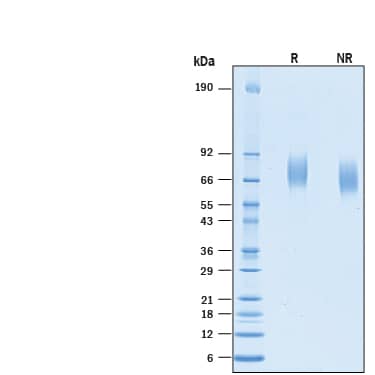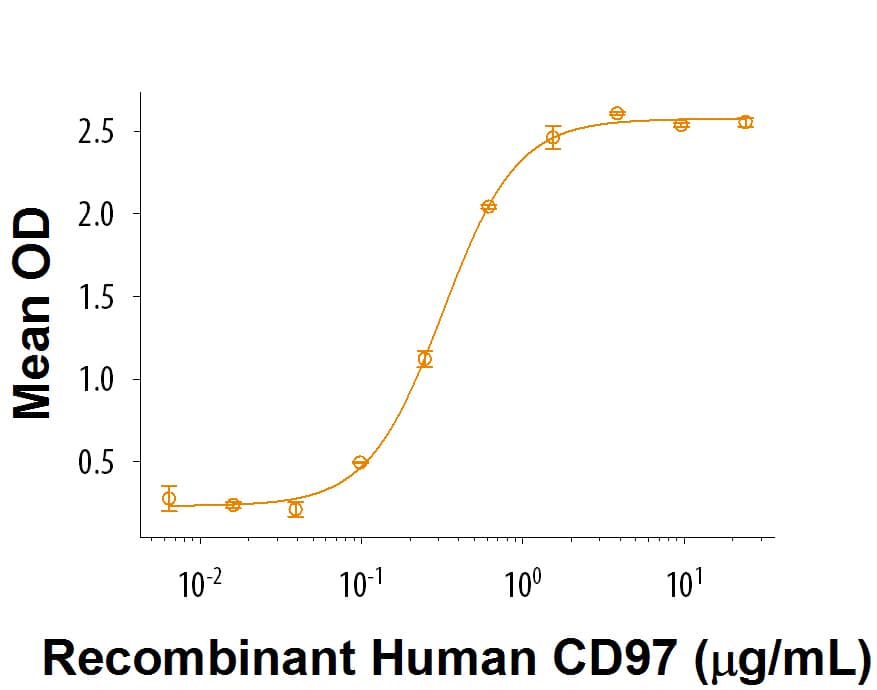Recombinant Human CD97 His-tag Protein, CF
R&D Systems, part of Bio-Techne | Catalog # 10134-CD

Key Product Details
Product Specifications
Source
Chinese Hamster Ovary cell line, CHO-derived human CD97 protein
Gln21-Gln398, with a C-terminal 6-His tag
Gln21-Gln398, with a C-terminal 6-His tag
Purity
>90%, by SDS-PAGE visualized with Silver Staining and quantitative densitometry by Coomassie® Blue Staining.
Endotoxin Level
<0.10 EU per 1 μg of the protein by the LAL method.
N-terminal Sequence Analysis
No results obtained. Gln21 is inferred from enzymatic pyroglutamate treatment revealing Asp22.
Predicted Molecular Mass
42 kDa
SDS-PAGE
60-90 kDa, under reducing conditions
Activity
Measured by the ability of the immobilized protein to support the adhesion of human red blood cells. Hamann, J. et al. (1996) J. Exp. Med. 184:1185.
The ED50 for this effect is 0.05-0.4 μg/mL.
The ED50 for this effect is 0.05-0.4 μg/mL.
Scientific Data Images for Recombinant Human CD97 His-tag Protein, CF
Recombinant Human CD97 His-tag Protein Bioactivity
Immobilized Recombinant Human CD97 (Catalog # 10134-CD) supports the adhesion of human red blood cells.The ED50 for this effect is 0.05‑0.4 μg/mL.Recombinant Human CD97 His-tag Protein SDS-PAGE
2 µg/lane of Recombinant Human CD97 His-tag (Catalog # 10134-CD) was resolved with SDS-PAGE under reducing (R) and non-reducing (NR) conditions and visualized by Coomassie® Blue staining, showing bands at 60-90 kDa.Formulation, Preparation and Storage
10134-CD
| Formulation | Lyophilized from a 0.2 μm filtered solution in PBS with Trehalose. |
| Reconstitution | Reconstitute at 500 μg/mL in PBS. |
| Shipping | The product is shipped with polar packs. Upon receipt, store it immediately at the temperature recommended below. |
| Stability & Storage | Use a manual defrost freezer and avoid repeated freeze-thaw cycles.
|
Background: CD97
References
- Veninga, H. et al. (2008) J. Immunol. 181:6574.
- Wobus, M. et al. (2004) Int. J. Cancer. 112:815.
- Lin, H.H. et al. (2001) J. Biol. Chem. 276:24160.
- Gray, J.X. et al. (1996) J. Immunol. 157:5438.
- McKnight, A.J. and S. Gordon (1998) J Leukoc. Biol. 63:271.
- Jaspars, L.H. et al. (2001) Tissue Antigens 57:325.
- Van Pel, M. et al. (2008) Haematologica 93:1137.
- Hamann, J. et al. (2019) J Exp Med. 184:1185.
- Leemans, J.C. et al. (2004) J. Immunol. 172:1125.
Alternate Names
CD97
Gene Symbol
ADGRE5
UniProt
Additional CD97 Products
Product Documents for Recombinant Human CD97 His-tag Protein, CF
Product Specific Notices for Recombinant Human CD97 His-tag Protein, CF
For research use only
